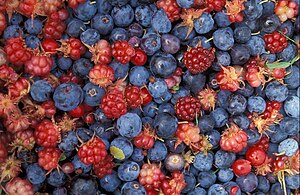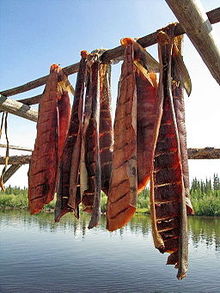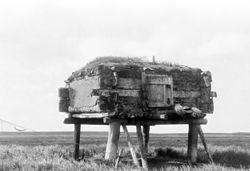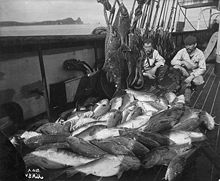Yupʼik cuisine
The Yup'ik, like other Eskimo groups, were semi-nomadic hunter-fisher-gatherers who moved seasonally throughout the year within a reasonably well-defined territory to harvest fish, bird, sea and land mammal, berry and other renewable resources.
The coastal settlements rely more heavily on sea mammals (seals, walrusses, beluga whales), many species of fish (Pacific salmon, herring, halibut, flounder, trout, burbot, Alaska blackfish), shellfish, crabs, and seaweed.
The inland settlements rely more heavily on Pacific salmon and freshwater whitefish, land mammals (moose, caribou), migratory waterfowl, bird eggs, berries, greens, and roots help sustain people throughout the region.
Long overlooked and pitifully misunderstood, the cuisine's roots lie buried in Eastern Asia, whence Iñupiaq and Yupik ancestors ventured to Siberia, across Beringia, and on to Alaska during the last ice age, 50,000 to 15,000 years ago.
Fortunately, dietitians consider the diet nutritious and balanced with abundant vitamins, minerals, proteins and valuable unsaturated fats derived from a vast array of sea and land mammals, fish, fowl, wild plants and berries.
[6][9] Also for salmon called neqpik ~ neqpiaq sg neqpiit ~ neqpiat pl in Yup'ik, means literally “real, genuine food”.
These include roasting (maniar-), barbecuing, baking (uute-), frying (assali-, asgir-), smoking (puyurte-, aruvarqi-, aruvir-), boiling (ega-), and steaming (puyiar(ar)-).
Instead, if there were more eggs than could be consumed at the time of collecting, they were hard-boiled and, still in their shells, placed in wooden dishes of seal oil to be kept for a short while.
The mousefood or mouse food (ugnaraat neqait) consists of the roots of various tundra plants which are cached by voles in burrows.
Bread (kelipaq Yukon, Kuskokwim, Hooper Bay and Chevak, Nelson Island, Canineq, Bristol Bay, Nushagak River, Lake Iliamna, Egegik, kelipar in Cup'ig from Russian хлеб khleb; qaqiaq bread in Yukon, Unaliq-Pastuliq from Iñupiaq qaqqiaq; qaq'uq in Yukon, Unaliq-Pastuliq from Iñupiaq qaqquq; kuv'aq in Yukon; tevurkaq in Unaliq-Pastuliq, tuurkaq in Lower Yukon from English dough) The uutaq is hard candy or other hard-baked food; bread[6] Flour (mukaaq in Yup'ik and Cup'ik, mukaar, muk'ar in Cup'ig from Russian мукá muká)[6] Fried bread (uqulek Hooper Bay and Chevak, uqurpag in Cup'ig; alatiq in Bristol Bay, alaciq in Egegik from Russian Оладьи [ru] alad’i)[6] The maniaq (Yup'ik and Cup'ik), maniar (Cup'ig) is pancake; fried bread; roasted thing[6] Frybread or fry bread (uqup'alek in Kuskokwim) is the characteristic widespread Native American homemade deep-fried biscuit, sometimes called “Eskimo doughnut” locally, known as “bannock” in Canada.
"Tea (caayuq in Yukon, Unaliq-Pastuliq, Hooper Bay and Chevak, Nelson Island, Upper Kuskokwim, Nushagak River, Lake Iliamna, Egegik, saayuq Lower Kuskokwim, Canineq, Bristol Bay, caayu Nunivak Cup'ig; from Russian чай chay) Coffee (kuuvviaq in Yup'ik and Cup'ik, kuupiaq in Unaliq, kuuvviar in Cup'ig; from Russian ко́фе kófe).
[30] Increasing EPA and DHA intakes to amounts well consumed by the general US population may have strong beneficial effects on chronic disease risk.
[32] Yup’ik Eskimos have a prevalence of type 2 diabetes of %3.3, versus %7.7 in the U.S. overall, even though the Yup’ik Eskimos have overweight/obesity levels similar to the rest of the U.S.[33] In a preliminary study initiated by the Center for Alaska Native Health Research (CANHR) at the University of Alaska Fairbanks, elders were significantly enriched in δ15N, but depleted in δ13C, relative to younger participants.
[10] Elevated cache or raised log cache, also raised cache or log storehouse (qulvarvik sg qulvarviit pl [Yukon, Kuskokwim, Bristol Bay, Nushagak River, Lake Iliamna], qulrarvik [Egegik], qaivarrvik, neqivik [Hooper Bay-Chevak, Yukon, Nelson Island], enekvak [Hooper Bay-Chevak], mayurpik [Hooper Bay-Chevak], mayurrvik [Nelson Island], ellivik [Kuskokwim], elliwig [Nunivak]) is a bear cache-like safe food storage place designed to store food outdoors and prevent animals from accessing it.
The cabin-on-post form may thus have been introduced by early traders, miners, or missionaries, who would have brought with them memories of the domestic and storage structures constructed in their homelands.
[35] For thousands of years, dogs (qimugta sg qimugtek dual qimugtet pl in Yup'ik and Cup'ik, qimugta sg qimugteg dual qimugtet pl in Cup'ig) as sled dogs, have been tightly interwoven in the Yup'ik way of life, for transportation and companionship.
Between late August and early October, coho salmon harvested for dog food were preserved by burying whole in earthen pits.
[25] The Yup'ik, like other Eskimo groups, were semi-nomadic hunter-fisher-gatherers who moved seasonally throughout the year within a reasonably well-defined territory to harvest fish, bird, sea and land mammal, berry and other renewable resources.
The coastal settlements rely more heavily on sea mammals (seals, walrusses, beluga whales), many species of fish (Pacific salmon, herring, halibut, flounder, trout, burbot, Alaska blackfish), shellfish, crabs, and seaweed.
The inland settlements rely more heavily on Pacific salmon and freshwater whitefish, land mammals (moose, caribou), migratory waterfowl, bird eggs, berries, greens, and roots help sustain people throughout the region.
Wild salmon, game meat, and berries harvested by Alaska Natives are world class fare compared to processed, canned, high priced items they find at their local mercantiles.
[27] Famine foods: reindeer lichen (tuntut neqait) was soaked in seal oil or mixed with cranberries to make it taste better.
[46] Indigenous plants were an integral part of the year-round diet of Eskimo people in addition to their incorporation in other facets of their life.
Contrary to the popular perception of Eskimo people surviving solely on fish and meat, the Nunivak Cup'ig utilized a large number of local plants for food, medicinal, and utilitarian purposes.
[47] On Nunivak, most indigenous plants were traditionally gathered by women and children when the men were harvesting other available resources (e.g., caribou, waterfowl, seal).
Depending on the time the ice pack began to break up, Cup'ig families would leave their winter villages and move to spring seal camps.
Fish were the most prolific and essential subsistence resource for many Alaskan Natives living in the Yukon-Kuskokwim Delta region and its harvest would occupy the majority of the families' efforts for several months.
Plants that grew in abundance in specific terrain, such as several varieties of cliff greens, usually offered other resources that could be harvested at the same time (e.g., fish, Sandhill cranes).
Greens such as Rumex arcticus (sour dock) could be found throughout the island and all old camp sites are said to contain buried cache pits once used for plant storage.
[47] Before placing the "wild spinach" or sour dock in the caches, the cooked leaves would be drained of juice and the pit lined with woven grass mats.














